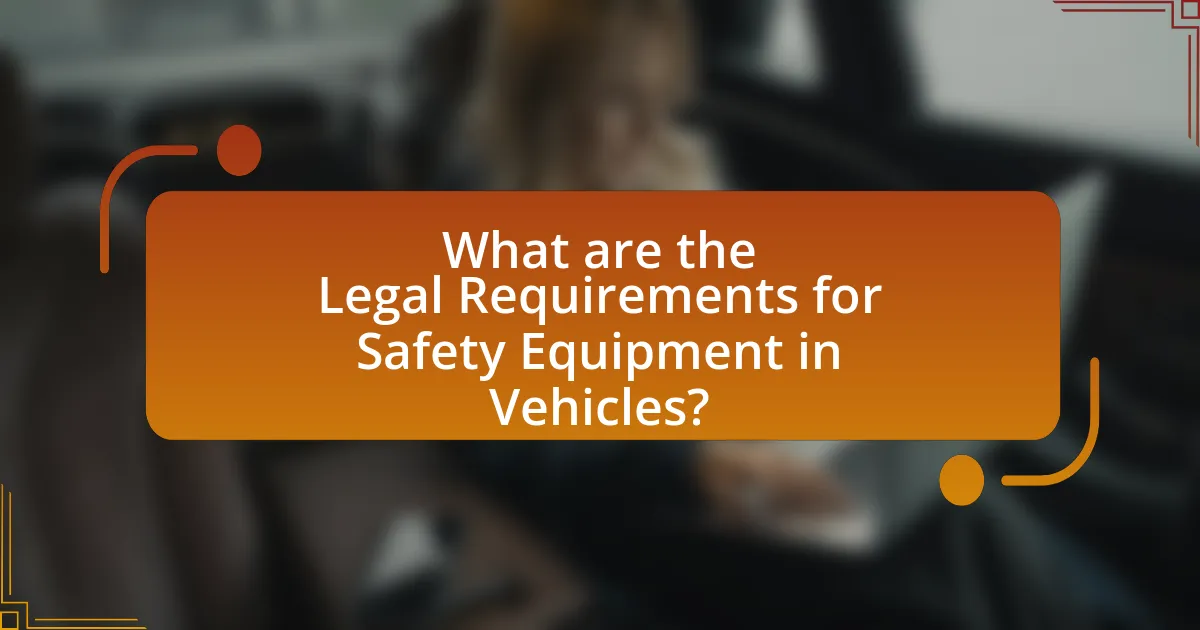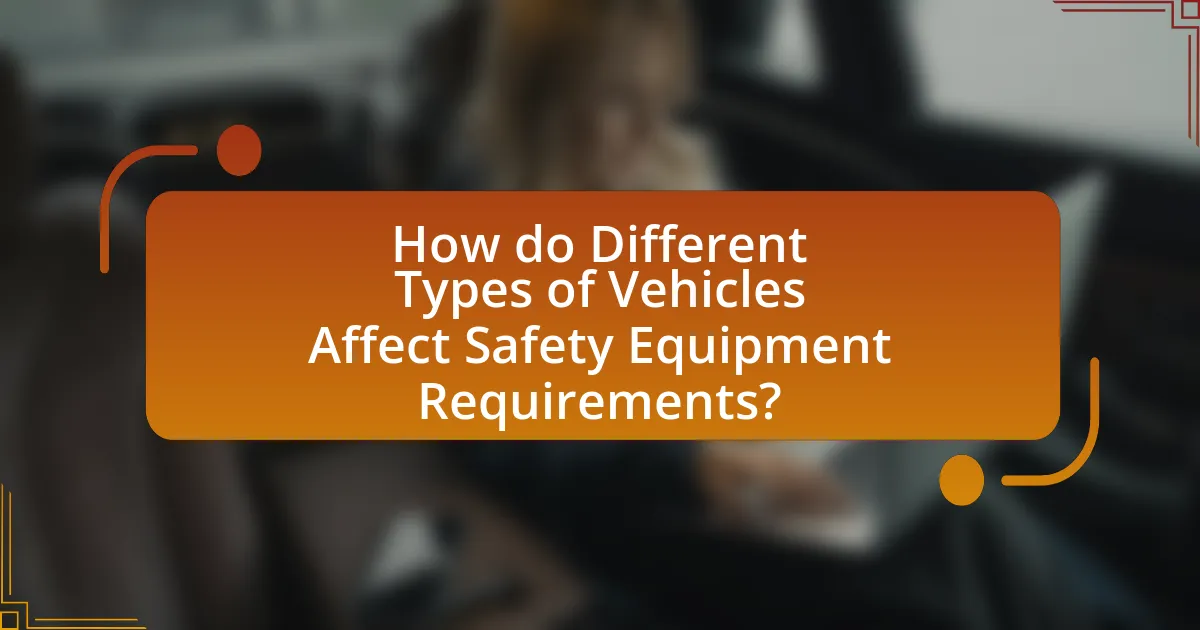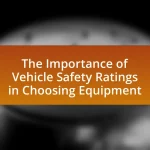The article focuses on the legal requirements for safety equipment in vehicles, detailing the mandatory features such as seat belts, airbags, and functioning lights that vary by jurisdiction. It emphasizes the importance of safety equipment in reducing injuries and fatalities during accidents, outlines the specific types of equipment mandated by law, and discusses the consequences of non-compliance, including legal penalties and insurance implications. Additionally, the article examines how safety equipment requirements differ across vehicle types and regions, the role of manufacturers in ensuring compliance, and best practices for vehicle owners to maintain safety standards.

What are the Legal Requirements for Safety Equipment in Vehicles?
The legal requirements for safety equipment in vehicles vary by jurisdiction but generally include mandatory features such as seat belts, airbags, and functioning brake lights. In the United States, for example, the National Highway Traffic Safety Administration (NHTSA) mandates that all passenger vehicles must be equipped with seat belts for all seating positions, and vehicles manufactured after a certain date must include airbags as standard equipment. Additionally, many states require vehicles to have functioning headlights, taillights, and turn signals to ensure visibility and communication with other drivers. These regulations are enforced to enhance occupant safety and reduce the risk of injury in the event of an accident.
Why is safety equipment important in vehicles?
Safety equipment is important in vehicles because it significantly reduces the risk of injury or death during accidents. The presence of safety features such as seat belts, airbags, and anti-lock braking systems has been shown to decrease fatalities by up to 50% in certain types of collisions. For instance, the National Highway Traffic Safety Administration reports that seat belts alone saved over 14,000 lives in 2019. Additionally, safety equipment helps ensure compliance with legal regulations, which mandate specific safety standards to protect drivers and passengers.
What types of safety equipment are mandated by law?
Safety equipment mandated by law includes seat belts, airbags, child safety seats, and reflective triangles. These requirements are established to enhance vehicle safety and reduce injuries in accidents. For instance, the National Highway Traffic Safety Administration (NHTSA) mandates that all passenger vehicles must be equipped with seat belts for all seating positions, and airbags are required in frontal crash zones to protect occupants. Additionally, child safety seats are legally required for children under a certain age or weight, ensuring their protection during travel. Reflective triangles are often required for commercial vehicles to alert other drivers in case of a breakdown.
How do legal requirements vary by region or country?
Legal requirements for safety equipment in vehicles vary significantly by region or country due to differing regulations, cultural norms, and enforcement practices. For instance, in the European Union, regulations mandate specific safety features such as electronic stability control and advanced braking systems, while in the United States, requirements may focus more on seatbelt laws and airbag deployment standards. These variations are influenced by factors such as road safety statistics, environmental considerations, and technological advancements, leading to a patchwork of legal standards globally. For example, according to the World Health Organization, countries with stringent vehicle safety regulations tend to have lower road traffic fatalities, highlighting the impact of legal requirements on public safety.
What are the consequences of non-compliance with safety equipment laws?
Non-compliance with safety equipment laws can result in significant legal and financial consequences for individuals and organizations. These consequences include fines, penalties, and potential legal action, which can arise from regulatory agencies enforcing safety standards. For instance, the Occupational Safety and Health Administration (OSHA) can impose fines that range from hundreds to thousands of dollars per violation, depending on the severity and nature of the non-compliance. Additionally, non-compliance may lead to increased liability in the event of accidents, as failure to adhere to safety regulations can be used as evidence of negligence in lawsuits. Furthermore, businesses may face reputational damage, loss of contracts, and increased insurance premiums, which can have long-term financial implications.
What penalties can be imposed for failing to meet safety equipment standards?
Penalties for failing to meet safety equipment standards can include fines, vehicle impoundment, and points on a driver’s license. Regulatory bodies, such as the National Highway Traffic Safety Administration (NHTSA), enforce these penalties to ensure compliance with safety regulations. For example, fines can range from hundreds to thousands of dollars depending on the severity of the violation, while repeated offenses may lead to increased penalties or legal action. Additionally, non-compliance can result in the suspension of vehicle registration or the inability to renew it until standards are met.
How does non-compliance affect insurance claims?
Non-compliance with legal requirements for safety equipment in vehicles can lead to the denial of insurance claims. Insurance companies often stipulate that policyholders must adhere to safety regulations; failure to do so can be interpreted as negligence. For instance, if a vehicle lacks mandatory safety features, such as airbags or seatbelts, and an accident occurs, the insurer may refuse to pay for damages, citing the policyholder’s non-compliance with safety laws as a reason. This principle is supported by various insurance policy clauses that explicitly state compliance with legal standards is a condition for coverage.

How do Different Types of Vehicles Affect Safety Equipment Requirements?
Different types of vehicles significantly influence safety equipment requirements due to variations in design, usage, and regulatory standards. For instance, passenger cars are mandated to have seat belts, airbags, and electronic stability control, while commercial trucks require additional equipment such as reflective tape, larger mirrors, and sometimes even collision avoidance systems due to their size and operational context. Furthermore, motorcycles must adhere to specific regulations that include helmets and visibility gear, reflecting their unique safety challenges. These requirements are often dictated by national and state laws, which aim to enhance safety based on the vehicle’s intended use and risk factors associated with its operation. For example, the National Highway Traffic Safety Administration (NHTSA) outlines distinct safety standards for different vehicle categories, ensuring that safety equipment is tailored to the specific risks each type presents.
What specific safety equipment is required for passenger vehicles?
Passenger vehicles are required to have specific safety equipment, including seat belts, airbags, and a functioning braking system. Seat belts are mandated for all occupants to reduce the risk of injury during a collision, while airbags provide additional protection in frontal crashes. The braking system must be reliable and effective to ensure safe stopping distances. These requirements are established by safety regulations, such as those from the National Highway Traffic Safety Administration (NHTSA), which aim to enhance passenger safety and reduce fatalities in road accidents.
What are the unique safety equipment requirements for commercial vehicles?
Commercial vehicles are required to have specific safety equipment to ensure compliance with regulations and enhance safety on the road. These requirements typically include items such as reflective triangles, fire extinguishers, first aid kits, and proper lighting systems. For instance, the Federal Motor Carrier Safety Administration mandates that commercial trucks must carry a fire extinguisher with a minimum rating of 5-B:C, and reflective triangles must be available for use in case of roadside emergencies. Additionally, commercial vehicles must have functioning brake lights, turn signals, and headlights to ensure visibility and communication with other road users. These regulations are designed to minimize risks and enhance safety for both the drivers and the public.
How do safety equipment requirements differ for motorcycles and bicycles?
Safety equipment requirements for motorcycles are more stringent than those for bicycles. Motorcycles typically require riders to wear helmets that meet specific safety standards, such as DOT or Snell certifications, while helmets for bicycles may not have such strict regulations and can vary widely in quality. Additionally, motorcycles must be equipped with features like turn signals, mirrors, and brake lights, which are not mandatory for bicycles. According to the National Highway Traffic Safety Administration, motorcycle riders are 28 times more likely to die in a crash than those on bicycles, highlighting the need for more comprehensive safety measures for motorcyclists.
What role do manufacturers play in meeting safety equipment regulations?
Manufacturers play a crucial role in meeting safety equipment regulations by designing, producing, and testing safety equipment to ensure compliance with established standards. They are responsible for adhering to regulations set by organizations such as the National Highway Traffic Safety Administration (NHTSA) in the United States, which mandates specific safety features in vehicles, including airbags and seatbelts. Compliance is verified through rigorous testing and certification processes, ensuring that the equipment meets safety performance criteria. For instance, manufacturers must conduct crash tests to demonstrate that their safety equipment can effectively protect occupants during collisions, thereby fulfilling legal obligations and enhancing consumer safety.
How do manufacturers ensure compliance with safety standards?
Manufacturers ensure compliance with safety standards by implementing rigorous testing and quality control processes throughout the production cycle. These processes include adhering to established regulations such as the Federal Motor Vehicle Safety Standards (FMVSS) in the United States, which outline specific safety requirements for vehicles. Manufacturers conduct regular audits, utilize certified testing laboratories, and maintain documentation to demonstrate compliance with these standards. For instance, the National Highway Traffic Safety Administration (NHTSA) mandates that manufacturers submit test results and safety data to verify that their vehicles meet safety criteria before they can be sold to consumers.
What are the implications of recalls related to safety equipment?
Recalls related to safety equipment have significant implications for manufacturers, consumers, and regulatory bodies. Manufacturers face legal liabilities and potential financial losses due to the costs associated with recalling defective products, which can include repair, replacement, and legal fees. Consumers are at risk of injury or death if they use faulty safety equipment, leading to a loss of trust in brands and products. Regulatory bodies may impose stricter compliance requirements and penalties for non-compliance, as seen in cases where the National Highway Traffic Safety Administration has mandated recalls for defective airbags and seatbelts. These implications highlight the critical importance of ensuring safety equipment meets legal standards to protect all stakeholders involved.

What are the Best Practices for Ensuring Compliance with Safety Equipment Laws?
The best practices for ensuring compliance with safety equipment laws include regularly reviewing and updating safety equipment to meet current regulations, conducting routine inspections and maintenance, and providing training for employees on the proper use of safety equipment. Regular reviews ensure that the equipment adheres to the latest standards set by regulatory bodies such as the Occupational Safety and Health Administration (OSHA) and the National Highway Traffic Safety Administration (NHTSA). Routine inspections help identify any deficiencies or needed repairs, while training ensures that all personnel understand the importance of compliance and how to use the equipment correctly. These practices collectively contribute to a safer environment and reduce the risk of legal penalties associated with non-compliance.
How can vehicle owners stay informed about safety equipment regulations?
Vehicle owners can stay informed about safety equipment regulations by regularly checking updates from government transportation agencies and industry organizations. These agencies, such as the National Highway Traffic Safety Administration (NHTSA) in the United States, provide official guidelines, safety recalls, and regulatory changes that affect vehicle safety equipment. Additionally, subscribing to newsletters from automotive safety organizations and following relevant social media channels can help vehicle owners receive timely information. According to the NHTSA, staying updated on safety regulations is crucial for compliance and ensuring the safety of both drivers and passengers.
What resources are available for understanding local safety equipment laws?
Local safety equipment laws can be understood through various resources, including government websites, legal databases, and safety organizations. Government websites, such as state Department of Motor Vehicles (DMV) or equivalent agencies, provide specific regulations and requirements for safety equipment in vehicles. Legal databases like Westlaw or LexisNexis offer access to statutes and case law related to safety equipment. Additionally, organizations such as the National Highway Traffic Safety Administration (NHTSA) publish guidelines and safety standards that are relevant to local laws. These resources collectively ensure accurate and comprehensive understanding of local safety equipment laws.
How can regular vehicle inspections help maintain compliance?
Regular vehicle inspections help maintain compliance by ensuring that vehicles meet safety and regulatory standards set by governing bodies. These inspections identify potential issues such as faulty brakes, worn tires, and malfunctioning lights, which can lead to violations of safety regulations. According to the National Highway Traffic Safety Administration, regular inspections can reduce the likelihood of accidents caused by vehicle defects, thereby promoting safer roadways and adherence to legal requirements. By consistently addressing maintenance needs through inspections, vehicle owners can avoid fines and penalties associated with non-compliance, ensuring their vehicles operate within the law.
What tips can help vehicle owners ensure their safety equipment is up to standard?
Vehicle owners can ensure their safety equipment is up to standard by regularly inspecting and maintaining all safety features, including seat belts, airbags, and brakes. Regular inspections should follow the manufacturer’s guidelines and local regulations, which often require specific safety equipment to be functional and compliant. For instance, the National Highway Traffic Safety Administration (NHTSA) mandates that vehicles must have operational seat belts and airbags to meet safety standards. Additionally, vehicle owners should keep records of maintenance and repairs to demonstrate compliance with safety regulations.
How often should safety equipment be checked or replaced?
Safety equipment should be checked at least once a month and replaced according to the manufacturer’s recommendations, typically every 1 to 5 years depending on the type of equipment. Regular inspections ensure that safety gear, such as seat belts, airbags, and fire extinguishers, remains functional and compliant with legal standards. For instance, the National Highway Traffic Safety Administration (NHTSA) advises that vehicle safety equipment should be maintained to meet safety regulations, which often stipulate specific timelines for checks and replacements.
What common mistakes should vehicle owners avoid regarding safety equipment?
Vehicle owners should avoid neglecting regular inspections and maintenance of safety equipment. Failing to check items such as seat belts, airbags, and brakes can lead to malfunction during critical situations, increasing the risk of accidents. According to the National Highway Traffic Safety Administration, proper maintenance of safety features can significantly reduce injury severity in crashes. Additionally, owners often mistakenly assume that all safety equipment is functional without verifying, which can result in non-compliance with legal safety standards. Regular checks and adherence to manufacturer guidelines are essential for ensuring that safety equipment remains effective and compliant with regulations.

